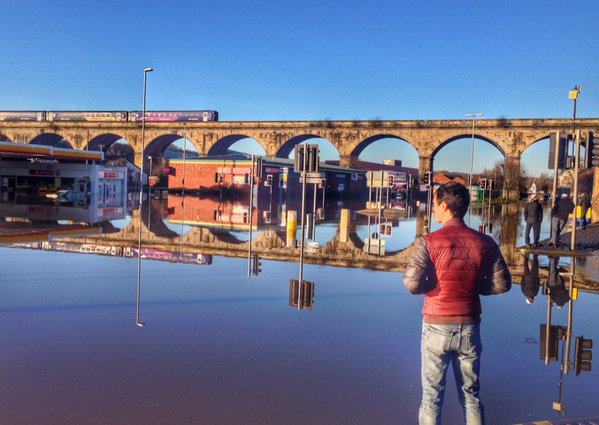Work has started on flood defences to protect Leeds city centre and the Kirkstall Valley.
Construction on the second phase of the Leeds Flood Alleviation Scheme will see flood defences being built on the River Aire upstream of Leeds Station.
The scheme aims to better protect 1,048 homes and 474 businesses in the area and follows the devastation left by Storm Eva on Boxing Day 2015, which left parts of Kirkstall Road and Kirkstall under several feet of water when the River Aire broke its banks.

The Phase 2 proposals are split into two steps and feature measures such as new defence walls, embankments and a large flood storage area.
The first step of Phase 2, at a cost of £87 million, will give protection against a one-in-100 chance of flooding in any given year along an 8km stretch upstream of Leeds station including three key areas – Leeds Industrial Museum at Armley Mills, Kirkstall Abbey and Kirkstall Meadows. These works are expected to be complete by winter 2022.

The second stage involves creating flood storage at Calverley, making use of an existing flood plain, and works at Apperley Bridge, which will bring the level of protection up to a one-in-200 chance of flooding in any given year, equivalent to the Boxing Day floods that hit areas such as Kirkstall in December 2015.

Today, works have started in the Wellington Bridge Street area upstream of the city centre, on a flood defence wall running along the River Aire.
Leader of Leeds City Council Councillor Judith Blake said:
“Seeing work happening on the ground will hopefully give reassurance to the communities, businesses and residents in the Kirkstall Corridor and upstream that soon they will have measures in place to prevent a repeat of the catastrophic damage and pain caused by the impact of Storm Eva.
“We continue to call on the government to provide the remaining funding or meet with us to discuss options so we can ensure all communities vulnerable to flooding from the River Aire have the highest possible level of flood defences in place, and our city is as resilient as we can make it to the increasing threat of extreme weather events due to climate change.”
Adrian Gill, area flood risk manager at the Environment Agency, said:
“This first step will provide much better protection from the River Aire upstream of Leeds station through the Kirkstall area and out to Newlay.
“The natural flood management measures that will be delivered across the catchment upstream as part of the first step will not only help reduce flood risk but also restore and create new habitat, increase biodiversity resilience and improve water quality.
“The team, led by Leeds City Council, will continue to share further detailed designs of the different zones of work with the residents, businesses and wider community of west Leeds as the construction works progress.”

The impact of Storm Eva in Leeds at Christmas 2015 affected 3,355 properties in Leeds, of which 672 were commercial businesses. The direct cost to the city was an estimated £36.8million, with the cost to the wider city region being more than £500million.
The Phase 2 work is being split into zones, and detailed designs are currently being worked on for future phases of work up the River Aire corridor. BMMjv, a joint venture between BAM Nuttall and Mott MacDonald, is designing and constructing the scheme.

The project also incorporates a flagship Natural Flood Management (NFM) programme. Natural flood management is when natural processes are used to reduce the risk of flooding.
The team is working with partners and landowners across the catchment to deliver a range of measures, such as the creation of new woodland and other natural features.
These techniques will hold back water to help reduce the flow of rainwater into the river and help reduce the impacts of climate change.

As part of the river channel maintenance element of the scheme, a small number of trees which have been assessed to be unstable or present a possible flood risk will be trimmed or removed and replaced by newly-planted trees.
The removed trees will be recycled as much as possible as part of the scheme, including helping to create new habitat along the river to support wildlife.
Some trees could be removed where it has not been possible to avoid them by changing the design of the flood defence construction works.
Three trees will be planted for every tree that is removed, with a preference of re-planting as close as possible. This is in addition to the thousands of trees being planted across the catchment as part of the NFM work.

The project has received an initial £65million from the Government as well as funding from Leeds City Council, West Yorkshire Combined Authority and Network Rail. Leeds City Council is committed to examining all options to secure the funding to deliver the scheme in full.
The work follows completion of the first phase of the Leeds Flood Alleviation Scheme in October 2017 where flood defences were installed along the River Aire in Leeds for the first time.
The £50million project began with works completed downstream in Woodlesford which proved effective during the Christmas 2015 flooding, before moving into the city centre with measures featuring the introduction of state-of-the-art moveable weirs at Crown Point and Knostrop to control river levels.

Other advanced measures include the part removal of redundant structures at Milford Place and underneath Gotts Bridge along with a number of NFM works at various locations throughout the catchment.
During construction, regular drop-in events will be held at the project team’s new site office on Viaduct Road, where people can stop by to ask any questions about the project.
The next session is on Wednesday 29 January from 10am until 2pm at Viaduct Road, LS4 2AP. After this they will run on the last Wednesday of every month.
For more details of the project visit this website.

